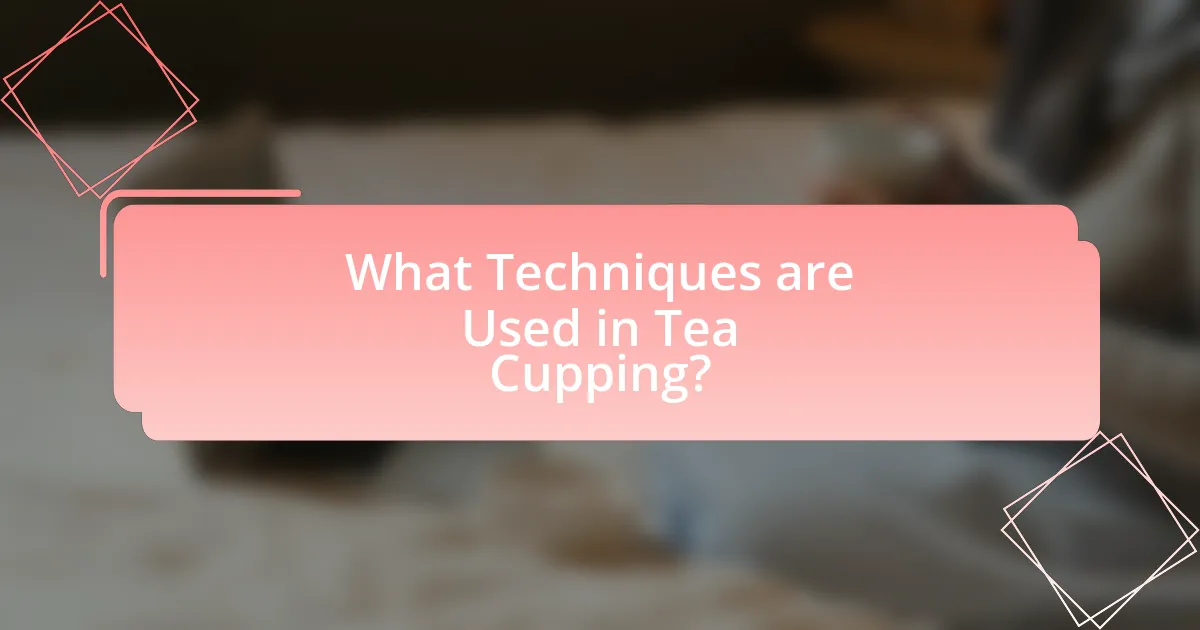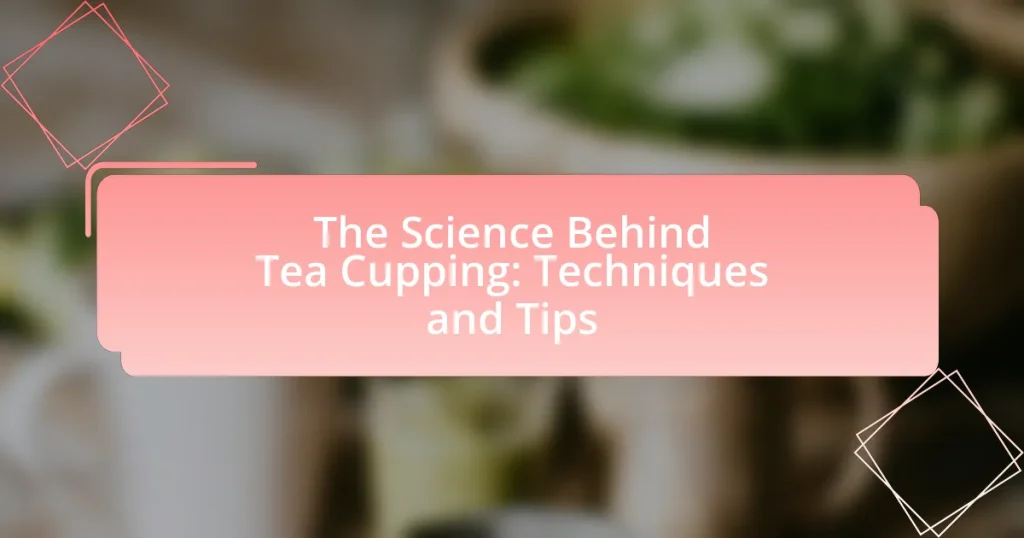Tea cupping is a systematic method for evaluating the aroma and flavor profile of tea, relying on principles of chemistry and sensory perception. This article explores the science behind tea cupping, detailing the techniques used, such as steeping and slurping, and the sensory components evaluated, including aroma, flavor, mouthfeel, and aftertaste. It also discusses how different tea types influence the cupping process, the importance of cupping for quality assessment in the tea industry, and best practices for conducting a successful cupping session. Additionally, tips for improving cupping skills and avoiding common mistakes are provided, emphasizing the significance of consistency and structured methods in achieving accurate flavor evaluations.

What is the Science Behind Tea Cupping?
Tea cupping is a systematic method used to evaluate the aroma and flavor profile of tea. This process involves steeping tea leaves in hot water and then assessing the resulting infusion through sensory analysis. The science behind tea cupping relies on the principles of chemistry and sensory perception, where volatile compounds released during steeping contribute to the tea’s aroma and taste. Studies have shown that specific compounds, such as catechins and amino acids, significantly influence flavor, while the temperature and steeping time can alter the extraction of these compounds, affecting the overall sensory experience.
How does tea cupping enhance the tasting experience?
Tea cupping enhances the tasting experience by allowing tasters to evaluate the aroma, flavor, and overall quality of tea in a controlled manner. This method involves steeping tea leaves in hot water and then assessing the brew’s characteristics through sensory analysis. The process emphasizes the release of volatile compounds, which are crucial for identifying the tea’s unique profile. Research indicates that cupping can improve the accuracy of flavor assessment, as it standardizes the brewing conditions, ensuring consistency across samples. This controlled environment enables tasters to discern subtle differences in taste and aroma, ultimately leading to a more informed and enjoyable tea experience.
What are the sensory components evaluated during tea cupping?
The sensory components evaluated during tea cupping include aroma, flavor, mouthfeel, and aftertaste. Aroma is assessed by smelling the brewed tea, which reveals volatile compounds contributing to the tea’s character. Flavor encompasses the taste profile, including sweetness, bitterness, and acidity, which are experienced on the palate. Mouthfeel refers to the texture and body of the tea, indicating its richness or lightness. Aftertaste is the lingering flavor that remains after swallowing, providing insight into the tea’s complexity and quality. These components are critical for determining the overall quality and characteristics of the tea being evaluated.
How do different tea types influence the cupping process?
Different tea types significantly influence the cupping process by affecting flavor profiles, aroma, and overall sensory experience. For instance, black teas typically yield robust flavors and strong aromas due to their oxidation level, while green teas offer more delicate and grassy notes because they are minimally processed. Oolong teas, which are partially oxidized, present a complex range of flavors that can vary widely depending on the specific variety and processing methods.
The cupping process itself involves steeping the tea leaves in hot water, allowing the unique characteristics of each tea type to emerge. For example, the temperature and steeping time can be adjusted based on the tea type to optimize flavor extraction; black teas often require higher temperatures and longer steeping times compared to green teas. This tailored approach ensures that the distinct qualities of each tea type are accurately assessed during cupping, leading to a more precise evaluation of their sensory attributes.
Why is tea cupping important for tea quality assessment?
Tea cupping is important for tea quality assessment because it provides a standardized method to evaluate the flavor, aroma, and overall characteristics of tea. This process allows tea professionals to identify specific qualities and defects in the tea, ensuring consistency and high standards in production. Research indicates that sensory evaluation through cupping can reveal nuanced differences in tea profiles, which are critical for grading and selecting high-quality teas.
What role does tea cupping play in the tea industry?
Tea cupping plays a critical role in the tea industry by serving as a standardized method for evaluating and comparing the quality of different teas. This practice allows tea professionals to assess flavor, aroma, and overall characteristics, ensuring consistency and quality control in tea production. According to the Specialty Tea Association, cupping is essential for sourcing high-quality teas, as it enables buyers to make informed decisions based on sensory analysis. Additionally, tea cupping helps in identifying unique flavor profiles, which can influence market trends and consumer preferences.
How does cupping contribute to flavor profiling?
Cupping contributes to flavor profiling by allowing tasters to assess the aroma and taste of tea through a standardized method. This technique involves steeping tea leaves in hot water and then slurping the infusion to aerate it, which enhances the perception of flavors and aromas. Research indicates that cupping helps identify specific flavor notes, such as floral, fruity, or earthy characteristics, by providing a consistent framework for evaluation. This method is widely used in the tea industry to ensure quality and consistency, as it enables professionals to compare different teas and make informed decisions based on their flavor profiles.

What Techniques are Used in Tea Cupping?
Tea cupping employs several techniques to evaluate the aroma, flavor, and quality of tea. The primary techniques include steeping, slurping, and assessing the visual appearance of the tea leaves and liquor. During steeping, tea leaves are infused in hot water for a specific duration, typically around five minutes, allowing the flavors to develop. Slurping is performed to aerate the tea, enhancing the perception of its aroma and taste. Additionally, evaluators observe the color and clarity of the brewed tea, which can indicate its quality. These techniques are standardized in professional cupping protocols, such as those outlined by the Specialty Tea Association, ensuring consistency and reliability in tea evaluation.
How is the tea cupping process conducted?
The tea cupping process is conducted by following a systematic method to evaluate the aroma and flavor of tea. First, loose tea leaves are measured and placed in cupping bowls, typically using about 5-8 grams of tea per cup. Next, hot water, usually at a temperature of around 95-100 degrees Celsius, is poured over the leaves to steep for a specific duration, generally 3-5 minutes. After steeping, the tea is assessed by smelling the aroma released from the wet leaves, followed by slurping the tea to evaluate its flavor profile. This method allows for a comprehensive analysis of the tea’s characteristics, including its aroma, taste, and mouthfeel. The process is standardized to ensure consistency and reliability in the evaluation of different tea varieties.
What are the steps involved in preparing for a tea cupping session?
To prepare for a tea cupping session, follow these steps: First, gather necessary materials including tea samples, cupping bowls, a scale, a kettle, and a timer. Next, measure the appropriate amount of tea leaves, typically around 8-10 grams per cup, and place them in the cupping bowls. Then, heat water to the ideal temperature for the specific type of tea being cupped, usually between 90-100 degrees Celsius. After that, pour the hot water over the tea leaves, ensuring they are fully submerged, and steep for the recommended time, usually 4-5 minutes. Finally, use a spoon to break the crust formed on the surface of the tea and evaluate the aroma before tasting. These steps ensure a standardized and effective cupping process, allowing for accurate flavor assessment.
How do you properly evaluate the aroma and flavor of tea?
To properly evaluate the aroma and flavor of tea, one should engage in a systematic process that includes visual inspection, aroma assessment, and tasting. First, visually inspect the dry leaves for color, shape, and size, as these characteristics can indicate the quality and type of tea. Next, smell the dry leaves to assess the initial aroma, which can reveal the tea’s freshness and potential flavor profile. After steeping the tea, evaluate the wet leaves’ aroma, which often provides a more accurate representation of the tea’s flavor.
When tasting, take a small sip and allow the tea to coat your palate, noting the initial flavor, body, and aftertaste. Pay attention to the balance of sweetness, bitterness, and acidity, as well as any specific flavor notes such as floral, fruity, or earthy. This methodical approach is supported by sensory evaluation techniques used in tea tasting, which emphasize the importance of a structured process to accurately assess the complex characteristics of tea.
What tools and equipment are essential for tea cupping?
The essential tools and equipment for tea cupping include cupping bowls, a kettle, a scale, a timer, and a spoon. Cupping bowls are typically small, wide, and shallow to allow for proper aroma assessment. A kettle is necessary for boiling water to the appropriate temperature for different types of tea. A scale ensures precise measurement of tea leaves, which is crucial for consistency in the cupping process. A timer is used to track steeping times accurately, while a spoon is needed for tasting the brewed tea. These tools collectively facilitate a standardized and effective tea cupping experience, allowing for accurate flavor and aroma evaluation.
What types of cups and utensils are recommended for cupping?
For cupping, porcelain or ceramic cups are recommended due to their ability to retain heat and provide a neutral flavor profile. These materials do not impart any unwanted tastes to the tea, allowing for a pure tasting experience. Additionally, glass cups can also be used, as they allow for visual assessment of the tea’s color and clarity. Utensils such as a spoon for stirring and a scale for measuring tea and water are essential for accurate preparation. The use of these specific materials and tools ensures that the cupping process is effective and that the flavors of the tea are evaluated accurately.
How does water temperature affect the cupping results?
Water temperature significantly influences cupping results by affecting the extraction of flavors and aromas from tea leaves. Higher temperatures typically extract more soluble compounds, leading to a fuller-bodied and more robust flavor profile, while lower temperatures may result in a lighter, more delicate taste. Research indicates that optimal water temperatures for different types of tea vary; for example, green teas are best brewed at lower temperatures (around 70-80°C) to avoid bitterness, whereas black teas benefit from higher temperatures (around 90-100°C) to fully release their flavors. This temperature-dependent extraction process is crucial for achieving the desired sensory characteristics in tea cupping.

What Tips Can Improve Your Tea Cupping Skills?
To improve your tea cupping skills, focus on consistency in your brewing parameters, such as water temperature, steeping time, and tea-to-water ratio. Consistent brewing ensures that you can accurately compare different teas and identify their unique characteristics. For instance, using a water temperature of 200°F (93°C) for black teas and 175°F (80°C) for green teas is essential for optimal extraction. Additionally, practice sensory evaluation techniques, including smelling the dry leaves, assessing the aroma of the wet leaves, and tasting the brewed tea, to enhance your ability to discern flavors and aromas. Regularly cupping a variety of teas will also build your palate and improve your overall skills.
How can you refine your palate for better tea tasting?
To refine your palate for better tea tasting, practice regular tasting sessions with a variety of teas to develop sensitivity to different flavors and aromas. Engaging in systematic tasting allows you to identify subtle notes and characteristics unique to each type of tea, such as floral, fruity, or earthy undertones. Research indicates that repeated exposure to diverse flavor profiles enhances sensory perception, making it easier to distinguish between them. Additionally, maintaining a neutral palate by avoiding strong flavors from food or beverages prior to tasting can further improve your ability to discern tea qualities.
What exercises can help enhance your sensory evaluation skills?
To enhance sensory evaluation skills, individuals can engage in systematic tasting exercises, such as blind tastings, where they evaluate various teas without knowing their identities. This method sharpens the ability to identify flavors, aromas, and textures. Additionally, practicing flavor pairing exercises, where participants match teas with specific foods, can improve the understanding of how different tastes interact. Research indicates that repeated exposure to diverse sensory experiences enhances perceptual acuity, making these exercises effective for developing sensory skills.
How can you document and compare your cupping notes effectively?
To document and compare your cupping notes effectively, utilize a structured format that includes specific categories such as aroma, flavor, acidity, body, and aftertaste. This method allows for consistent evaluation across different tea samples. By assigning numerical scores or descriptive terms to each category, you can create a clear comparison between various teas. Research indicates that standardized scoring systems enhance the reliability of sensory evaluations, as seen in studies on sensory analysis in food and beverage industries. This structured approach not only aids in personal reflection but also facilitates discussions with others in the tea community, ensuring that comparisons are based on shared criteria.
What common mistakes should be avoided in tea cupping?
Common mistakes to avoid in tea cupping include using incorrect water temperature, not allowing the tea to steep long enough, and failing to use a consistent amount of tea leaves. Using water that is too hot can scorch delicate teas, while water that is too cool may not extract the full flavor profile. Insufficient steeping time can lead to underdeveloped flavors, and inconsistency in the amount of tea can result in unreliable comparisons. These practices are critical for achieving accurate and meaningful results in tea cupping, as they directly affect the flavor, aroma, and overall assessment of the tea.
How can improper brewing techniques affect cupping outcomes?
Improper brewing techniques can significantly distort cupping outcomes by altering the extraction of flavors and aromas from the tea leaves. For instance, incorrect water temperature can lead to under-extraction or over-extraction, resulting in a brew that is either weak and lacking complexity or overly bitter and astringent. Additionally, inconsistent steeping times can further compromise the balance of flavors, making it difficult to accurately assess the tea’s quality. Research indicates that optimal brewing parameters, such as precise temperature and timing, are crucial for achieving a representative flavor profile, as demonstrated in studies on tea extraction methods.
What are the pitfalls of not following a structured cupping method?
Not following a structured cupping method can lead to inconsistent flavor profiles and inaccurate assessments of tea quality. Without a systematic approach, variables such as steeping time, water temperature, and tea-to-water ratio may vary, resulting in unreliable taste evaluations. Research indicates that standardized methods enhance reproducibility in sensory analysis, which is crucial for quality control in tea production. For instance, the Specialty Coffee Association emphasizes the importance of consistency in cupping to ensure that flavor notes are accurately identified and compared across different samples.
What are the best practices for hosting a tea cupping session?
The best practices for hosting a tea cupping session include selecting high-quality teas, using proper equipment, and maintaining a controlled environment. High-quality teas ensure a more accurate assessment of flavors and aromas, while essential equipment includes cupping bowls, spoons, and a kettle for boiling water. A controlled environment, ideally with consistent lighting and minimal distractions, allows participants to focus on the sensory experience. Additionally, following a standardized cupping protocol, such as using the same water temperature and steeping time for each tea, enhances the reliability of the results. These practices are supported by industry standards, such as those outlined by the Specialty Coffee Association, which emphasize consistency and quality in sensory evaluation.


